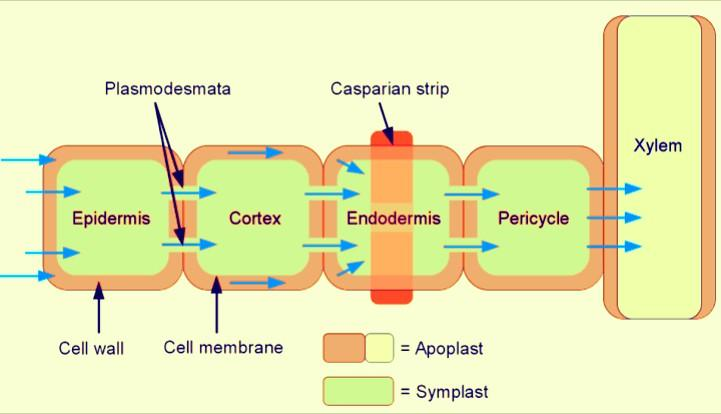
Root hair absorbs water from the soil through
A. Turgor pressure
B. Ion exchange
C. Osmosis
D. DPD
Answer
512.7k+ views
1 likes
Hint: Absorption of water is related to the process of transpiration.
Complete answer:
Root hairs are present in the zone of maturation of roots. They absorb water from the soil by the simple process of osmosis. It is a passive mechanism and no energy expenditure is required.
The mechanism of passive absorption of water is as follows:
- This process is seen in rapidly transpiring plants.
- Due to transpiration which is the loss of water vapor from the leaf surface, a pull is generated that acts along the length of xylem bundles. This pull acts as a force of water absorption and is known as transpirational pull.
- Due to this pull, the water present between soil particles (capillary water) is pulled through the root system of plants.
- It is a completely passive procedure and 96-98% of water reabsorption takes place by this procedure.
- Transpiration pull is also the fastest method of water absorption in plants.
Additional Information:
The water moves through the roots in the following two pathways:
- Symplastic Pathway: The movement of water occurs through the protoplasm of the plant cell. The cytoplasm and plasmodesmata connection are associated with symplastic transport.
- Apoplastic pathway: Transport of water occurs through the cell walls and intercellular spaces of the plant cell. It does not involve any living component like cytoplasm.

So, the correct answer is, “ Root hair absorbs water from the soil through osmosis.”
Note: Even though a maximum of the water absorption occurs by passive method, a small percentage of 2-4% of water absorption takes place by active method (osmotic active and non-osmotic active absorption)So, the correct answer is, "Herbivorous animals can digest cellulose because of bacteria present in their caecum help in the digestion of cellulose."
Complete answer:
Root hairs are present in the zone of maturation of roots. They absorb water from the soil by the simple process of osmosis. It is a passive mechanism and no energy expenditure is required.
The mechanism of passive absorption of water is as follows:
- This process is seen in rapidly transpiring plants.
- Due to transpiration which is the loss of water vapor from the leaf surface, a pull is generated that acts along the length of xylem bundles. This pull acts as a force of water absorption and is known as transpirational pull.
- Due to this pull, the water present between soil particles (capillary water) is pulled through the root system of plants.
- It is a completely passive procedure and 96-98% of water reabsorption takes place by this procedure.
- Transpiration pull is also the fastest method of water absorption in plants.
Additional Information:
The water moves through the roots in the following two pathways:
- Symplastic Pathway: The movement of water occurs through the protoplasm of the plant cell. The cytoplasm and plasmodesmata connection are associated with symplastic transport.
- Apoplastic pathway: Transport of water occurs through the cell walls and intercellular spaces of the plant cell. It does not involve any living component like cytoplasm.

So, the correct answer is, “ Root hair absorbs water from the soil through osmosis.”
Note: Even though a maximum of the water absorption occurs by passive method, a small percentage of 2-4% of water absorption takes place by active method (osmotic active and non-osmotic active absorption)So, the correct answer is, "Herbivorous animals can digest cellulose because of bacteria present in their caecum help in the digestion of cellulose."
Latest Vedantu courses for you
Grade 11 Science PCM | CBSE | SCHOOL | English
CBSE (2025-26)
School Full course for CBSE students
₹41,848 per year
Recently Updated Pages
Express the following as a fraction and simplify a class 7 maths CBSE

The length and width of a rectangle are in ratio of class 7 maths CBSE

The ratio of the income to the expenditure of a family class 7 maths CBSE

How do you write 025 million in scientific notatio class 7 maths CBSE

How do you convert 295 meters per second to kilometers class 7 maths CBSE

Write the following in Roman numerals 25819 class 7 maths CBSE

Trending doubts
State and prove Bernoullis theorem class 11 physics CBSE

What are Quantum numbers Explain the quantum number class 11 chemistry CBSE

Write the differences between monocot plants and dicot class 11 biology CBSE

1 ton equals to A 100 kg B 1000 kg C 10 kg D 10000 class 11 physics CBSE

State the laws of reflection of light

One Metric ton is equal to kg A 10000 B 1000 C 100 class 11 physics CBSE




